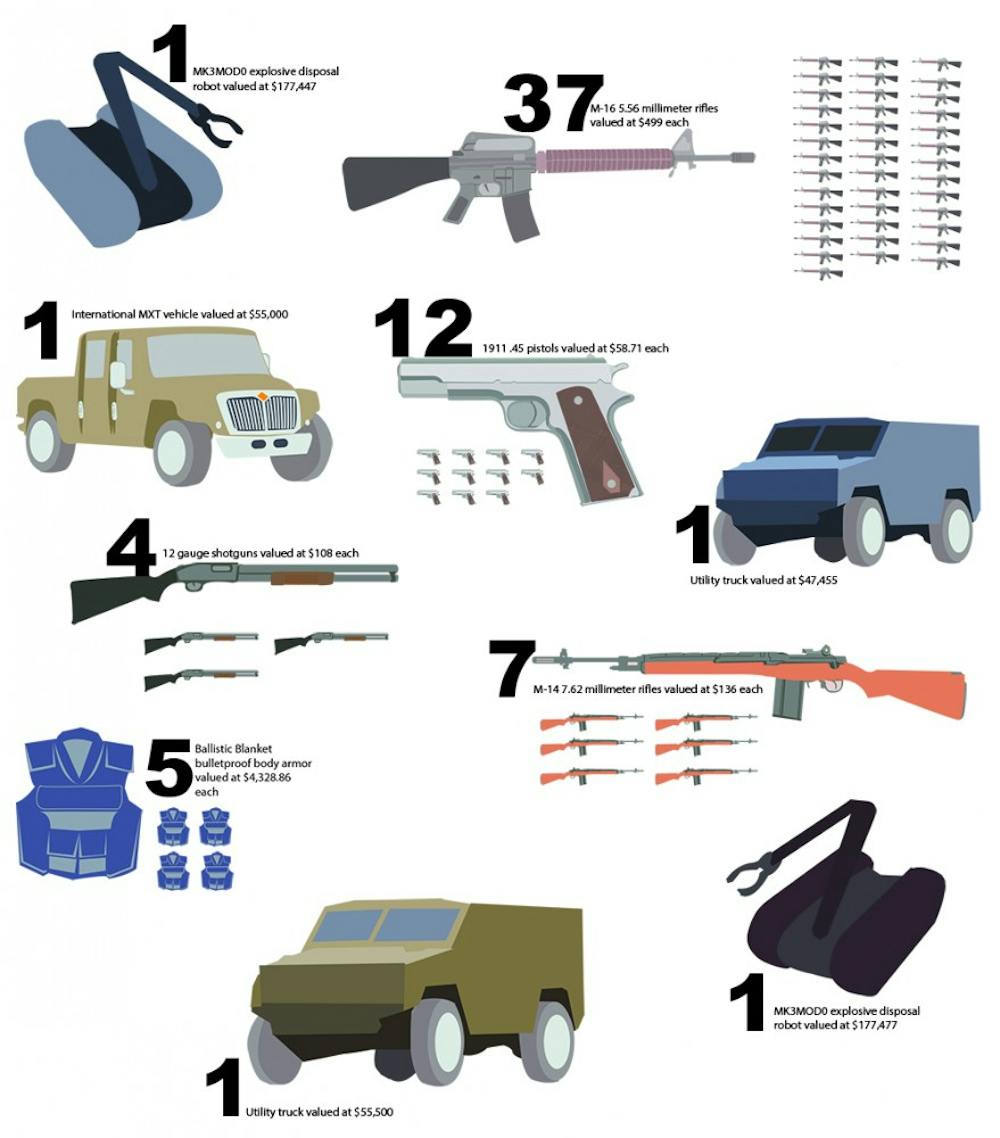“The reason we have (specialized weapons) is whenever we go on any sort of call, (we) try to anticipate what potential threat might be and protect officers accordingly,” he said. “Driving around responding to a loud party or a disorderly subject, there might be no imminent threat, but there is always the possibility for some sort of violence.”
That possibility is the reasoning behind what is called the 1033 program, otherwise known as the Department of Defense Excess Property Program.
Utilizing military hand-me-downs
Through the 1033 program, Ingham County and the police departments included in it have been able to receive $1.1 million dollars in surplus military equipment and supplies — equipment and supplies that otherwise would be funded by taxpayers.
Ingham County Undersheriff Allan Spyke said program 1033 procurements are not all weaponry — the county has also acquired basic necessities, like shirts, towels, boots and even a barber kit, to use during training and to supply officers.
While Spyke acknowledged the program has the potential to be abused by some agencies, he said Ingham County keeps the specialized weapons, like rifles and armored cars, around for extreme circumstances so officers don’t “risk their lives unnecessarily.”
“There is definitely a need for it,” he said. “Going into a situation where there is an armed gunman, police officers need to protect themselves.”
That can sometimes require 37 M-16 5.56 millimeter rifles, seven M-14 7.62 millimeter rifles, four 12-gauge shotguns and multiple utility trucks, all of which Ingham County has acquired under the 1033 program.
Although Ingham County is given surplus items directly from the military, some special precaution is taken by the department to alter the weaponry to suit their needs.
Spyke said the M-16 rifles are currently being converted from fully to semi-automatic, the 12-gauge shotguns will only shoot bean bags and the M-14 rifles are only to be used for funerals and other police ceremonies.
And while the armored cars have seen some use in the past year, Spyke said the vehicles are mainly used for off-road searches.
“A lot of times when you’re trying to find an armed suspect, or an elderly person who has wandered away off in the brush — a patrol car can’t drive there. (Utility vehicles) allows us to go there.”
Spyke added the vehicles are also functional in flooding conditions, which can be useful during rainy seasons.
While Spyke said he understands the public’s wariness of militarized or military-made weapons, the concern for public safety is what fuels the program.
“The police, I think, have always been viewed as an ambivalent force, that has been around since police have been around. People want to enjoy all those freedoms but at the same time we want to be safe,” Spyke said. “I think it’s a wonderful program. Will Ingham County continue to do it? Yes. Do I think there should be oversight? Yes, and there is oversight.”
Bringing out the big guns
Team commander of the Ingham Regional Special Response Team Lt. Matt Merony manages the specialized equipment MSU police uses, although he says military-obtained weapons are few and far between at the MSU Department of Police and Public Saftey.
Merony said his department uses standard-issue pistols, as well as rifles available to civilians. The armored car the department owns was not obtained from the military, but purchased as a refurbished model, he said.
Support student media!
Please consider donating to The State News and help fund the future of journalism.
Additionally, the department has gear used to deal with “civil disorders.”
According to Merony, the department has specialized protective equipment including helmets with face shields, padded suits to go over uniforms and chemical munitions, in addition to some less-lethal impact munitions.
“This is nothing new to police work, this type of equipment has been standard issue for police forces since civil disorders became a problem,” he said in an email.
Murphy declined to give specifics about what kind of military-obtained equipment his department has, but said the supplies are utilized often.
For instance, an armored car was used to apprehend a suspect in a double homicide this summer at a Lansing Rite Aid and at a home on Coolidge Road. Additionally, East Lansing police broke out riot gear for the civil disturbance that followed MSU football’s Big Ten championship win over Ohio State in December 2013.
“We try to match the level of protection with anticipated threat, from riot gear up to an armored vehicle,” Murphy said. “(Using the equipment) every day would be a little over-the-top, because we can’t say every day we anticipate the threat of being shot at, but when we do, we would be pretty negligent if we didn’t have our officers ride in armored vehicle.”
Besides standard-issue handguns, Murphy said officers are also equipped with rifles that are stashed in the trunks of patrol cars. The military began giving out rifles in the wake of school shootings, Murphy said, to allow officers to neutralize a threat at a greater distance.
Murphy said his department has acquired some military-grade weapons in the past, but those have since been phased out with age.
“Recently we’ve gotten things like military-style first aid kits for self-treatment, so if (officers) were ever injured during a call, they could treat each other or themselves until they could get expert treatment,” Murphy said.
The East Lansing Police Department is lucky to be a part of the 1033 program, he added.
“When the worst thing happens and there’s ... violence, police have no option. Police have to confront (the violent person). Everyone else can get in their house or leave the area or what they need to do to be safe,” Murphy said. “Public safety is the most basic thing we do. That’s why we have access to as much safety equipment as we need. We strive to make it a little less dangerous, and if we can get it free from the military we can use our resources on other things.”
While Murphy understands how the public could be put off by riot gear or other weapons, he said public safety is always the department’s No. 1 concern.
“Our thinking here was if we can get rifles and equip officers with the best weapons, they can give the best protection to the public when they’re needed,” Murphy said.
Assessing the necessity of militarized weapons
Criminal justice professor William Terrill believes it is important for police departments to have access to militarized weapons, but emphasized only using the equipment when necessary.
“I think from the public side, the police have always been a quasi-military organization, that’s why they have rank on their shoulder and do a lot of things like the military,” Terrill said. “The public overlooks the fact that they are (a) military organization.”
It’s not until a police department takes a strong approach to militarization that the public begins to feel uneasy.
“I think you had an agency that’s ill-prepared for this type of unrest, if this would have happened in New York ... officers would have been well-trained and equipped so when it occurred, they would keep the heavy-handed stuff out of public view,” Terrill said.
David Carter, a criminal justice professor and director of the law enforcement intelligence and analysis master’s program at MSU, said the national concern over police militarization could be prevented if local agencies established a better, more trustworthy relationship with the citizens they serve.
“I think having (militarized weapons) available for a police department is a necessity. The question is, how are they deployed?” Carter said. “Who has the training, and what are the terms of using them under what policy and circumstances?”
Being from Missouri originally, Carter said he has heard about the unrest in Ferguson, Mo., that broke out last month as a result of the death of a reportedly unarmed black teen.
Carter said the protests have been inflamed by the media in the area, who Carter believes made the issue much bigger than it originally was. Carter said a host of problems with police in the area caused the upset.
“Police should have responded more forthrightly and a little bit sooner. Who knows why they didn’t,” he said. “I’m guessing it was a bit of someone made a bad judgement and they were poorly trained in terms of dealing with civil disturbances. Some of the tape I saw, and the behaviors (of officers), I cringe at that myself.”
Matt Maher, a criminal justice sophomore who has been keeping an eye on the events in Ferguson said police agencies should have access to the specialized weaponry, but should stick to what usually works — non-military equipment.
“I think (the events in Ferguson) are just an isolated incident and I honestly don’t see the point of every law enforcement agency looking to militarize,” Maher said. “I think if there has been a history of violence there’s a need for it. But there’s not a need for it in places around here, just because what they have now usually works.”
Discussion
Share and discuss “Armed” on social media.







